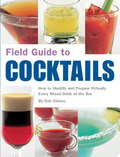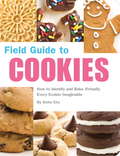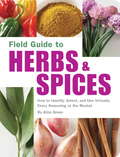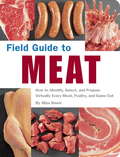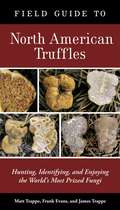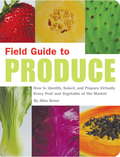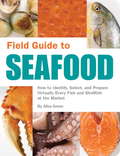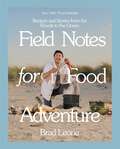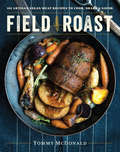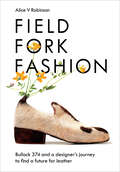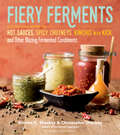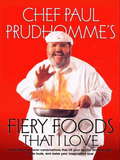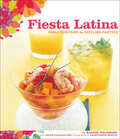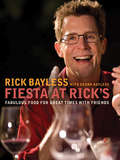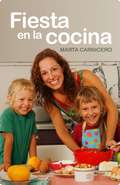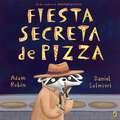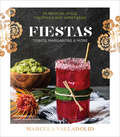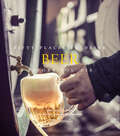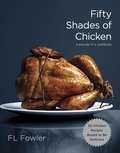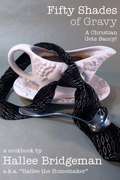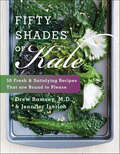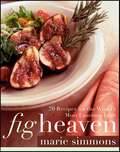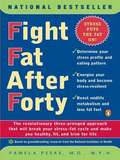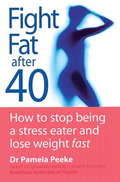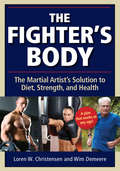- Table View
- List View
Field Guide to Cocktails
by Rob ChiricoFinally, a field guide to preparing and identifying virtually every drink at the bar, from the Añejo Highball to the Caipirinha, from the Singapore Sling to the Zombie! Field Guide to Cocktails is not an ordinary bartender's guide. Here are more than 200 recipes for the world's best libations, with tried-and-true classics like the Tom Collins and the Fuzzy Navel and contemporary favorites like the Mojito and the Cosmopolitan. Full-color photographs of the cocktails are cross referenced to in-depth descriptions of the drinks. The histories are the stuff of legend: The Gin Rickey was mixed up to satisfy a thirsty lobbyist; Grog was drunk by sailors in the British Navy to prevent scurvy; and the Gibson was originally just a glass of water with an onion in it. You'll also learn the most appropriate time and season to enjoy the drink, and you'll get suggestions for the perfect food pairings--lobster with a Cape Codder, sharp cheese and crackers with a Gin and Tonic, black bean dip and chips with a Cuba Libre, and more. So whether you're planning a cocktail party or trying to identify a new drink to try at the bar, Field Guide to Cocktails is the only mixology book you'll ever need. Cheers!
Field Guide to Cookies
by Anita Chu Caroline RomanskiAt last, a field guide to baking and identifying virtually every cookie imaginable, from Snickerdoodles to Pfeffernusse! Field Guide to Cookies is the definitive guide to cookies from around the world, with more than 100 recipes and variations on such tried-and-true classics as gingersnaps, whoopie pies, and pinwheels as well as traditional international favorites like pizzelles, baklava, and alfajores. This delectable guide introduces readers to the best techniques for creating drop, bar, molded, rolled, and sandwich variations. Every cookie is photographed in glorious full color, with step-by-step instructions on how to prepare, bake, and store your creations. Entries include fascinating historical background, helpful baking notes, and serving suggestions for each delicious variety. Whether you're a baking novice or veteran pastry chef, mouthwatering home-baked confections are just minutes away with Field Guide to Cookies!
Field Guide to Herbs and Spices
by Aliza GreenField Guide to Herbs & Spices will forever change the way you cook. With this practical guide--including full-color photographs of more than 200 different herbs, spices, and spice mixtures--you'll never again be intimidated or confused by the vast array of spices available. Learn to discern the differences between the varieties of basil, the various colors of sesame seeds, the diverse types of sugar and salt, and even how to identify spice pastes like zhoug, harissa, and achiote. Each entry features a basic history of the herb or spice (saffron used to be worth more than gold!), its season (if applicable), selection and preparation tips, a recipe featuring the seasoning, and some suggested flavor pairings. Complete with more than one hundred recipes, Field Guide to Herbs & Spices is a must-have resource for every home cook. Meals will never be the same again!
Field Guide to Meat
by Aliza GreenAt last, a field guide to identifying and selecting more than 200 different cuts and kinds of meat, from beef and poultry to game and cured meat! An essential resource for every home cook or chef, Field Guide to Meat offers details on virtually every kind of meat available. This practical guide includes more than 200 full-color photographs of cuts of beef, veal, pork, lamb, game, and poultry as well as more than 100 different kinds of cured meats and sausages. Cross-referenced with the photographs are in-depth descriptions of the cuts, including basic history, location in the animal, characteristics, information on how to choose the cut, and flavor affinities. Step-by-step preparation directions tell you whether the item is best marinated, braised, grilled, roasted, or pan-seared. Trips to the butcher's aisle will no longer be intimidating, and you'll never end up with a cut that's too tough for dinner.
Field Guide to North American Truffles: Hunting, Identifying, and Enjoying the World's Most Prized Fungi
by James M. Trappe Frank Evans Matt TrappeThe second most expensive food in the world after saffron, truffles are treasured, coveted, and savored for their mysterious and exotic flavor. This complete field guide shows chefs and fungi aficionados how to forage for and identify the wide variety of truffles that grow in temperate forests throughout North America. Written by expert horticulturalists who have studied, classified, and enjoyed truffles for decades, the FIELD GUIDE TO NORTH AMERICAN TRUFFLES makes these celebrated underground jewels accessible to all. The first full-color illustrated guide to identifying North American truffles by their key features, including profiles of more than 80 species of truffles. Includes more than 80 photographs of rare and hard-to-find truffle species. Features flavor profiles, delectability index, and culinary tips for each species. Perfect size for carrying in a pocket or daypack.Reviews"It'¬?s the first book of its kind, complete with photographs, cross-sectional views of indigenous truffle varieties, guides to seasonal availability, and foraging tips for hundreds of kinds of truffles (both the edible and inedible kinds), as well as tasting notes and cooking tips."-SaveurFrom the Trade Paperback edition.
Field Guide to Produce
by Aliza GreenAt last, a field guide to identifying and selecting more than 200 fruits and vegetables from around the world! The perfect companion for every shopper, Field Guide to Produce offers tips for selecting, storing, and preparing everything from apples to zucchini. When an unfamiliar edible appears on your grocer's shelf, simply flip through the full-color insert until you've found its photograph. Turn to the corresponding page to discover its country of origin, common uses, and season of harvest. This practical guide includes more than 200 full-color photographs of the world's most popular fruits and vegetables, cross-referenced to in-depth descriptions and selection tips. Step-by-step preparation directions tell you whether the item must be peeled, washed, trimmed, or blanched. Grocery shopping--and dinner--will never be the same again!
Field Guide to Seafood
by Aliza GreenAt last, a field guide to identifying and selecting seafood from around the world, including barramundi, lobsterette, wahoo, and more! With the daunting array of fish and shellfish available in today's market, Field Guide to Seafood is a must-have for every seafood consumer! This helpful guide offers a comprehensive look at seafood, covering more than 100 different kinds of fish and shellfish, plus preserved fish, fish sauces, and caviar. Learn to differentiate between Arctic char and salmon or between snow crabs and stone crabs with the in-depth descriptions and full-color photographs. Each entry contains a list of alternate names, characteristics, and suggested preparation, including directions on when to remove or leave the skin. Step-by-step instructions explain how to identify, store, and cook the item. Whether your fish is store-bough or just caught, this guide includes selection tips, suggested recipes, and complementary flavors. You'll never feel overwhelmed by the wide variety of seafood with this handy guide -- don't go shopping without it!
Field Notes for Food Adventure: Recipes and Stories from the Woods to the Ocean
by Brad LeoneA FOOD52 BEST COOKBOOK OF THE YEARJoin Brad Leone, star of Bon Appetit's hit YouTube series It's Alive, for a year of cooking adventures, tall tales, and fun with fire and fermentation in this cookbook with more than 80 ingenious recipes Come along with Brad Leone as he explores forests, fields, rivers, and the ocean in the hunt for great food and good times. These pages are Brad&’s field notes from a year of adventures in the Northeast, getting out into nature to discover its bounty, and capturing memorable ideas for making delicious magic at home anytime. He taps maple trees to make syrup, and shows how to use it in surprising ways. He forages for ramps and mushrooms, and preserves their flavors for seasons to come. He celebrates the glory of tomatoes along with undersung fruits of the sea like squid and seaweed. Inspiration comes from hikes into the woods, trips to the dock, and cooking poolside in the dead of summer. And every dish has a signature Brad Leone approach—whether that&’s in Sous Vide Mountain Ribs or Spicy Smoked Tomato Chicken, Sumac Lemonade or Fermented Bloody Marys, Cold Root Salad, Marinated Beans, or just a few shakes of a Chile Hot Sauce that&’s dead simple to make. This is a book about experimentation, adventure, fermentation, fire, and having fun while you&’re cooking. And hey, you might just learn a thing or two. Let&’s get going!
Field Roast: 101 Artisan Vegan Meat Recipes to Cook, Share, and Savor
by Tommy McdonaldHailed as 2015's Company of the Year by VegNews Magazine, the Field Roast Grain Meat Co. offers their first cookbook, with over 100 delicious, satisfying vegan recipesIn Field Roast, Chef Tommy McDonald shares fundamental techniques and tips that will enable you to make your own vegan meats at home--for everyday (sandwiches, burgers, meatloaf) to holiday (stuffed roast, anyone?), as well as recipes for using them in every meal from breakfast through dinner. The 100 recipes are flexible: want to make your own plant-based meats? Great! Want to use Field Roast products instead? That will work too. All you need are grains, veggies, and spices--easy-to-find whole food ingredients for authentic, hearty taste. With basics such as cutlets and sausages, along with dishes like Burnt Ends Biscuit Sandwich, Chicken Fried Field Roast and Waffles, Pastrami on Rye, Tuscan Shepherd's Pie, Curry Katsu, (and even some favorite desserts), Field Roast brings new meaning to plant-based meat.
Field, Fork, Fashion: Bullock 374 and a Designer’s Journey to Find a Future for Leather
by Alice V Robinson*From one of the Vogue Business 100 Innovators List - 2023 "[T]his wonderful project and book, executed with great charm and creativity, is an important message." Anya Hindmarch In this personal investigation into ethical and traceable leather, fashion designer Alice Robinson begins a ground-breaking journey into the origin story of leather and its connection to food and farming. As a fashion student, Alice started to question the material she worked with. Leather is universally acknowledged as a luxury material, from which desirable bags, shoes and clothing are made. But how much do we know about where it comes from? Alice’s questions led back to her childhood home in rural Shropshire, where she decided to buy Bullock 374 and follow its journey from a local farm to the abattoir, then to the butchery and finally to the tannery. The journey culminates with Alice’s own design practice as she creates a collection based on this single hide. In doing so, Alice would begin to see the bigger picture – and connect farm, food and fashion for the first time to understand the true meaning of provenance, value and beauty.
Fiery Ferments: 70 Stimulating Recipes for Hot Sauces, Spicy Chutneys, Kimchis with Kick, and Other Blazing Fermented Condiments
by Kirsten K. Shockey Christopher ShockeyThe authors of the best-selling Fermented Vegetables are back, and this time they&’ve brought the heat with them. Whet your appetite with more than 60 recipes for hot sauces, mustards, pickles, chutneys, relishes, and kimchis from around the globe. Chiles take the spotlight, with recipes such as Thai Pepper Mint Cilantro Paste, Aleppo Za&’atar Pomegranate Sauce, and Mango Plantain Habañero Ferment, but other traditional spices like horseradish, ginger, and peppercorns also make cameo appearances. Dozens of additional recipes for breakfast foods, snacks, entrées, and beverages highlight the many uses for hot ferments.
Fiery Foods That I Love
by Paul PrudhommeChef Paul has traveled around the globe, brought back its flavors, and dreamed them into such mouthwatering, soul-satisfying recipes as Fire-Roasted Garlic Bread; Fennel and Split Pea Soup; Fried Eggplant coated in sesame seeds; Pepper Tomato Shrimp; Sweet Beef and Fresh Chiles; Smothered Potatoes, Cabbage, and Andouille; and much, much more. And he's even added his "Too Hot for Mrs. Podunk" recipes for those of you hungry for five-alarm flavor. Those in search of Chef Paul's favorites, just look for his trademark cap.
Fiesta Latina: Fabulous Food for Sizzling Parties
by Rafael Palomino Arlen GargaglianoWhether you want to throw a cocktail party with sizzle or a dinner party with wow, this is your inspirational guide for a Latin-style evening to remember.Here are more than sixty recipes in a Latin-inspired cookbook guaranteed to get the party started. With some of the hottest Latin restaurants on the east coast to his credit, Rafael Palomino knows how to throw a proper fiesta. His vibrant, accessible recipes for pasabocas (appetizers), main courses, and desserts will grant any host or hostess the powers for effortless entertaining. Fusion treats like Chipotle Crabmeat and Sweet Plantain Empanadas, and Sugar Cane Shrimp Skewers are a fresh take on cocktail food. Just say ceviche and there’s an entire chapter devoted to zesty takes like Blood Orange, Shrimp and Mango-Wasabi. With color-drenched photos, mix-and-match salsitas and sauces, and plenty of Latin flair, here’s very good food for very good times.“Fiesta Latina offers just what you’d expect from the lively title: a variety of impressive dishes perfect for serving at your next gathering . . . Readers looking to explore exotic Latin cuisine with their friends and family will be thrilled with Fiesta Latina.” —BookLoons
Fiesta at Rick's: Fabulous Food for Great Times with Friends
by Rick Bayless Deann Groen BaylessEntertaining made easy, with Mexican-inspired recipes and handy tips from the celebrity chef and winner of Bravo's Top Chef Masters. Whether you're hosting a casual get-together with friends or throwing an outdoor shindig, no one can teach you the art of fiesta like Rick Bayless. With 150 recipes, Bayless offers you the key to unforgettable parties that will have guests clamoring for repeat invitations. There are recipes for small-dish snacking (Mushroom Ceviche, Devilish Shrimp), dynamic cocktails to get the party started (Champagne Margarita, Sizzling Mojito), and Bayless's signature takes on Mexican street food (Grilled Pork Tacos al Pastor, Roasted Vegetable Enchiladas). Live-fire grilled fish and meat dishes like the "Brava" Steak with "Lazy" Salsa will draw friends and family to the glow of open flames. And if you're going to throw a truly epic celebration, you'll need a killer finale like Frontera Grill's Chocolate Pecan Pie Bars or Dark Chocolate-Chile Ice Cream. Fiesta at Rick's offers 150 diverse preparations organized into easy-to-follow chapters. But it's far more than a collection of recipes. With four complete, can't-miss menus for parties ranging from a Luxury Guacamole Bar Cocktail Party for 12 to a Classic Mexican Mole Fiesta for 24, Bayless has all your friends covered. Each of these parties has a complete game plan, from a thought-out time line with advance shopping and preparation to a fiesta playlist. Whether a first-time entertainer or a seasoned veteran, anyone can learn from the helpful sidebars, which cover topics such as how to shuck oysters, the perfect avocado for guacamole, and the best way to pick out fresh fish for ceviche preparations. Bayless breaks down the timeless building blocks that make up authentic Mexican food, explaining the value of fresh tortillas and providing surprisingly simple instructions for making your own Mexican Fresh Cheese. Bayless's entertaining blueprint eliminates the guesswork, so you can let your inspiration run free. Companion to seasons six and seven of Rick's Public Television series Mexico--One Plate at a Time, Fiesta at Rick's is required reading for everyone who loves opening their home to friends and good times.
Fiesta en la cocina
by Marta CarniceroCocinar es divertido y así tenemos que comunicárselo a los más pequeños de la casa. En la cocina los niños aprenden, adquieren autonomía, ganan en autoestima, se atreven a probar alimentos nuevos y, además, están entretenidos.Fiesta en la cocina es un recetario muy completo al estilo tradicional que invita a participar a los más pequeños y a los chicos que ya pueden hacer sus primeros pinitos solos: son recetas pensadas especialmente para que a los niños les resulte fácil elaborarlas, sanas y muy apetecibles para el paladar infantil y el de toda la familia.Desde dulces para animar una tarde lluviosa, golosinas para una fiesta, recetas sin fogones para los más pequeños, batidos fresquitos para el verano, recetas rápidas para los que tienen mucha prisa, platos fríos para cuando llegamos de la playa, tapas deliciosas, pizzas para una noche de sábado divertidísima, platos para una cena de cada día, menús para sorprender a los padres... Un sinfín de ideas deliciosas a las que nadie se podrá resistir.
Fiesta secreta de pizza
by Adam Rubin* “With a casually diverse cast of characters, Secret Pizza Party is a sure hit for primary-grade kids, who will appreciate the subtle humor and absurdity.”—School Library Journal, starred reviewHow does Racoon love pizza? Oh, let him count the ways. He loves the gooey cheesy-ness, salty pepperoni-ness, sweet sweet tomato-ness, and of course the crispity crunchity crust. But someone is always chasing poor Raccoon away from his favorite food with a broom! What's a hungry raccoon to do? Plan an elaborate secret pizza party, of course! But shhh! It’s a secret! In fact, you should probably just forget I told you. Nope, no secret pizza party happening here.You didn’t already tell all your friends, did you? Uh oh . . .Fans of Jon Klassen and Mo Willems's humor will gobble up this quirky ode to the lengths we will go to for our heart's desire.
Fiestas: Tidbits, Margaritas & More
by Marcela ValladolidMarcela Valladolid loves to entertain guests at her beautiful home in San Diego, and just as she did in Casa Marcela, this book captures the spirit of her hybrid Mexican-American upbringing in vibrant and mouthwatering recipes. Picadillo Lettuce Cups are topped with avocado and lime and make for perfect finger food; Spicy Chimichurri and Jalapeño-Cilantro Aioli are the perfect addition to a crudite platter; the classic panzanella salad is updated with tomatillos, panela cheese, and pork rinds; and vegetarian options include Chickpea Ceviche Tostadas and Sweet Potato Chipotle Hummus. Of course there are plenty of cocktails, too—Strawberry Basil Cardamom Margaritas, a Mexican-inspired Old-fashioned, Orange Cinnamon Sour, and the Kalimotxo, a red wine and Mexican Coke sangria.
Fifty Places to Drink Beer Before You Die: Beer Experts Share the World's Greatest Destinations (Fifty Places Ser.)
by Chris SantellaA beautiful guide to the world’s fifty best places to enjoy a beer, from Alabama to Zimbabwe, as chosen by experts connected to the industry.What is the most unforgettable place you’ve ever taken a refreshing sip of a cold beer? In Fifty Places to Drink Beer Before You Die, Chris Santella explores the best destinations to crack open a cold one, reflect on the day, and take in the scenery. The book features the world’s top locations for imbibing, from beautiful landscapes to beer festivals, breweries, classic drinking establishments, and brand-new, under-the-radar spots. With a mix of national and international places to visit—Asheville, Denver, Prague, Munich, Vienna, and more—as well as firsthand accounts from contributors such as Jim Koch (founder of Boston Brewing Company/ Samuel Adams) and Joe Wiebe (author of Craft Beer Revolution), this book will make you want to trek to each must-see destination. Packed with beautiful, vibrant photographs that bring each locale to life, Fifty Places to Drink Beer Before You Die will leave you craving barley and hops and eagerly planning your next trip.
Fifty Shades of Chicken
by F. L. FowlerDripping Thighs, Sticky Chicken Fingers, Vanilla Chicken, Chicken with a Lardon, Bacon-Bound Wings, Spatchcock Chicken, Learning-to-Truss-You Chicken, Holy Hell Wings, Mustard-Spanked Chicken, and more, more, more! Fifty chicken recipes, each more seductive than the last, in a book that makes every dinner a turn-on. "I want you to see this. Then you'll know everything. It's a cookbook," he says and opens to some recipes, with color photos. "I want to prepare you, very much." This isn't just about getting me hot till my juices run clear, and then a little rest. There's pulling, jerking, stuffing, trussing. Fifty preparations. He promises we'll start out slow, with wine and a good oiling . . . Holy crap. "I will control everything that happens here," he says. "You can leave anytime, but as long as you stay, you're my ingredient." I'll be transformed from a raw, organic bird into something--what? Something delicious. So begins the adventures of Miss Chicken, a young free-range, from raw innocence to golden brown ecstasy, in this spoof-in-a-cookbook that simmers in the afterglow of E.L. James's sensational Fifty Shades of Grey trilogy. Like Anastasia Steele, Miss Chicken finds herself at the mercy of a dominating man, in this case, a wealthy, sexy, and very hungry chef. And before long, from unbearably slow drizzling to trussing, Miss Chicken discovers the sheer thrill of becoming the main course. A parody in three acts--"The Novice Bird" (easy recipes for roasters), "Falling to Pieces" (parts perfect for weeknight meals), and "Advanced Techniques" (the climax of cooking)--Fifty Shades of Chicken is a cookbook of fifty irresistible, repertoire-boosting chicken dishes that will leave you hungry for more.With memorable tips and revealing photographs, Fifty Shades of Chicken will have you dominating dinner.From the Hardcover edition.
Fifty Shades of Gravy; A Christian Gets Saucy!: A Cookbook and a Parody
by Hallee BridgemanFifty Shades of Gravy "a Christian Gets Saucy!" is a cookbook wrapped in a parody surrounded by a comedy with a tongue firmly inserted into a cheek - but the recipes are deadly serious and may leave readers licking the gravy boat. Hallee Bridgeman, A.K.A. "Hallee the Homemaker" rides the gravy train to triumph and hilarity with her premiere cookbook, revealing the secrets of the penultimate comfort food - gravy. Her famous whole food, real food recipes bathe in luxuriant liquid comfort with recipes that are sure to captivate and enslave any audience. Hallee starts with stocks and broths and then explores every shade of gravy you can whip up. Some recipes are entire meals and some are simple sauces while still others are gravies served alongside a traditional holiday feast. There are meaty gravies, comfort food gravies, vegan gravies, gluten-free gravies, and even chocolate gravies! For any gravy question you were too ashamed to ask, this saucy Christian shares the answer.
Fifty Shades of Kale: 50 Fresh & Satisfying Recipes That are Bound to Please
by Drew Ramsey Jennifer IserlohKale gets sexy in Fifty Shades of Kale by Drew Ramsey, M.D., and Jennifer Iserloh, with 50 recipes that are mouth-wateringly delicious and do a body good. Release yourself from the bondage of guilt and start cooking meals with the ingredients you love: meat, cheese, and yes—even butter. Nutrient-rich kale provides essential vitamins and minerals to keep you healthy, happy, and lean—so you can indulge in your most delicious desires. Whether you’re a cooking novice or a real kale submissive, you will undoubtedly succumb to Kale’s charms.From Mushroom and Kale Risotto to Kale Kiwi Gazpacho, Fifty Shade of Kale offers simple ways to have your kale and eat it, too, as well as nutritional information, cooking tips, and a tutorial on kale in all her glorious shades. Indulge your culinary passions with Fifty Shades of Kale: 50 Fresh and Satisfying Recipes That Are Bound to Please.
Fig Heaven: 70 Recipes for the World's Most Luscious Fruit
by Marie SimmonsThey come fresh or dry, in yellow or purple, from California and Mediterranean and Middle Eastern countries. They are in restaurants, supermarkets, fruit stands, backyards, and inside some very famous cookies. What are they? They're figs -- one of America's favorite fruits.From Mission and Kadota figs to Adriatic and Calimyrna varieties, award-winning cookbook author Marie Simmons leaves no fig or fig leaf unturned in this extraordinary book about this most extraordinary fruit: Fig Heaven.Figs are harvested in late summer and early fall, but, fortunately for us, they are easily dried and packaged, so they're available all year long. Packed with vitamins and antioxidants, plump, fragrant figs are guilt-free indulgences that can be enjoyed in countless ways.Fig Heaven is an inviting, comprehensive cookbook offering 70 recipes for both fresh and dried figs. They range from appetizers, salads, and sandwiches to entrées and desserts.On the savory side, you'll find Open-Faced Dried Fig and Melted Blue Cheese Sandwiches; Fettuccine with Fresh Figs, Lemon, and Rosemary; and Lamb Pilaf with Artichokes and Dried Figs. If your sweet tooth needs some real satisfaction, there's a Fresh Fig and Peach Crumble, Dried Fig and Walnut Biscotti, and Molten Chocolate Roasted Figs with Vanilla Custard Sauce.
Fight Fat After Forty
by Pamela PeekeIt's a fact: stress makes you fat. Renowned clinician and scientist Dr. Pamela Peeke goes beyond diet and exercise with a lifestyle program that shows women how to stop being diet "POWs" ("Prisoners Of Weight") or victims of "Toxic Stress" and how to evolve into physically and mentally stress-resilient individuals. Peeke helps women identify their stress-eating profiles (Are you a stress-overeater? A stress-undereater?) and explains that to remove weight, you have to lift weight. She explains what to eat and, equally as important, when to eat by navigating the afternoon "CortiZone," the hours of highest vulnerability to stress eating. Learn how to put it all together through the fine art of regrouping.Women can tailor this accessible program to their individual needs using Peeke's three behavior templates:* Stress-resilient nutrition* Stress-resilient physical activity* Stress-resilient regroupingDr. Peeke's program is a must for women who want to break the stress-fat cycle that has thickened their after-forty waistlines.
Fight Fat After Forty: How to stop being a stress eater and lose weight fast
by Dr Pamela PeekeIt's not only food and inactivity that can make you fat in midlife - so can stress. After the age of forty, the accrued stresses of a lifetime and the inevitable onset of the perimenopause begin to take their physical toll on a woman. This toxic stress builds emergency fat inside the body and leads to bad eating regimes, particularly in the over-forties. In Fight Fat After Forty renowned clinician and scientist Dr Pamela Peeke explains her revolutionary plan for fighting stress-eating and shedding 'toxic weight' forever. Reveals that stress makes you fat! Offers a revolutionary three-pronged approach of stress-resilient nutrition, stress-resilient physical activity and stress-resilient 'regrouping' (keeping motivated) Helps you identify your stress profile and eating pattern and offers a healthy eating programme to suit your body. Contains a weekly exercise and stress-reducing programme· Helps you to boost midlife metabolism and lose weight fast Discover how to: * Attack weight with a week-by-week stress-reducing nutrition, exercise and motivation programme * Identify your stress profile and follow the eating programme that suits your body * Boost your midlife metabolism and lose weight fast!
Fighter's Body: The Martial Artist's Solution to Diet, Strength, and Health
by Loren W. Christensen Wim DemeereYou have an owner's manual for your car, your stereo, and even your blender, so why not your body? The Fighter's Body is exactly that--an owner's manual for your most complex piece of equipment.As a martial artist, you make special demands of your body. Have you ever wondered how that latest fad diet might affect your performance on the mat? Ever wanted to take off a few extra pounds? How about putting on muscle without slowing down? Making weight for a tournament? Losing five pounds fast? Eating better? Changing weight classes? Are you confused about supplements, vitamins, and protein shakes? Don't know where to start? Start here.This book will answer your questions about important topics including* Why some diets are harmful for martial artists * How to calculate your protein needs for training* When and how to use supplements* How to eat at fast food places and not ruin your diet* Why it's OK to splurge on "dirt day"* How to safely make weight for a tournament* Why HIIT training is essential to weight loss* What to eat on competition days* How to create a plan that works and stick to itLoren W. Christensen and personal trainer Wim Demeere combine their knowledge of martial arts, weight training, nutrition, diet, and exercise to answer your questions and put you on the road to becoming the best martial arts athlete you can be.
